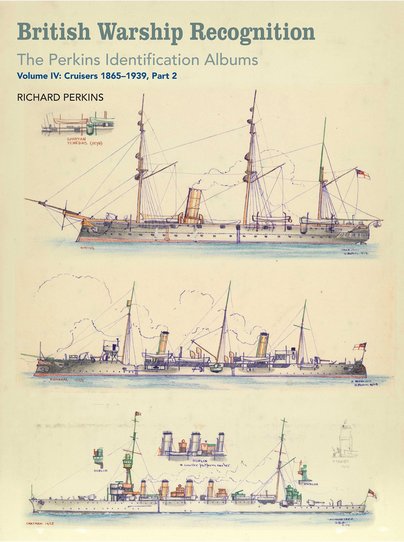
British Warship Recognition: The Perkins Identification Albums. Volume IV: Cruisers 1865-1939, Part 2. By Richard Perkins. Seaforth Publishing, Barnsley, 2017. ISBN 978-1-4738-9149-4. £60.00 RRP in the UK.
Reviewed by David Hobbs
THE latest in Seaforth Publishing’s series of identification albums by the late Richard Perkins, published in association with the UK National Maritime Museum, Part 2 of Volume IV covers 203 ships in the broad light cruiser category from HMS AMAZON of 1865 to HMS CAMBRIAN of 1916. Included within this total are a number of ships that will be of interest in Australia including HMA Ships PIONEER, ADELAIDE, BRISBANE, MELBOURNE and SYDNEY.
Given the fact that SYDNEY’s foremast still exists as a memorial on Bradley Head in Sydney Harbour, it is interesting to study Perkins’ sketches on page 40 of how this structure evolved with an enlarged spotting top and director after 1917. In addition to the RAN ships, there are details of HM Ships PEGASUS, PROMETHEUS, PSYCHE, KATOOMBA, MILDURA, RINGAROOMA, TAURANGA and WALLAROO, all of which served on the Australia Station of the RN between 1905 and 1911. HM Ships PYRAMUS and PHILOMEL that served on the New Zealand Station are also included. Among the historically interesting RN cruisers are HMS HERMIONE which was modified to act as a depot ship for the RN’s first rigid airship, R1 unofficially known as ‘Mayfly’, in 1911; HMS HERMES which was modified to become the RN’s first seaplane carrier for the Fleet Exercises of 1913; HMS VINDICTIVE of Zeebrugge fame and the ships that were expended as block-ships in that operation.
The entries are grouped in their appropriate classes and each ship has coloured side elevations that show changes at different stages of their careers including, where applicable, appearances as coal hulks, depot ships, drill ships for reserve personnel and other duties towards the end of their lives. As well as the whole ship elevations, there are detailed sketches of masts, yards, aerial arrays, spotting tops, funnel arrangements and individual ship markings where these were applied. Scuttle arrangements are also shown in some cases, where these differed between ships of the same class. There are also brief details of ships’ service histories showing the Fleets, Squadrons and Stations in which they served, when they were in dockyard hands for refit and when they served as flagships.
With such detailed information it should be possible to identify and date photographs of the subject ships throughout their lives up to 1939. This feature of the original albums has been an invaluable resource at the National Maritime Museum’s photograph archive at Woolwich for many years and I can imagine that anyone with an interest in the development of the warships of this period, or with a collection of photographs to identify and catalogue more accurately will find this volume an important addition to their bookshelves. Yes it is expensive but for a recommended retail price that equates to dinner for one at a good restaurant you get a lot of information, coloured drawings that have been reproduced to a high quality and fascinating detail sketches. I value my copy and recommend this new volume of a unique series highly.



